Menu

Over 70 governments have agreed to hit net-zero carbon emissions by 2050. Achieving this goal will need huge money – about $1-2 trillion each year. In Europe, hitting these green targets means investing $3.8 trillion in new energy projects by 2050.
Working together across industries, especially farming and green energy, is a key approach. This mix brings agricultural skills and clean power together. It’s essential for creating real change and pushing the world’s energy plans forward.
This teamwork combines different sectors’ skills and resources. An example is the work in green hydrogen by ADNOC, BP, and Masdar. Such efforts show that joining hands beats national borders. International talks are vital for solving many problems.
Many on the global stage are working hard on these challenges. Groups like the International Chamber of Shipping (ICS) and the International Renewable Energy Agency (IRENA) push for less carbon in shipping. They highlight the power of many areas working as one.
Global progress on energy and sustainability needs many sectors to work together. This collaboration brings new ideas and solutions. It helps meet goals like reducing carbon emissions.
In the mission for sustainable development, working together is key. The 2030 Agenda highlights this, showing that by joining forces, we can reach more goals. Imagine the positive change possible when digital and clean energy sectors unite their efforts.
Many areas are combining their skills for a greener world. The work of groups in construction, like architects and engineers, is a good example. They create buildings that use less energy and water. Likewise, businesses such as Adidas are pushing towards eco-friendly practices in big ways. Their goals for recycled materials show their dedication.
Some partnerships have made a real difference. Let’s look at the agreement between the ICS and IRENA to lower maritime shipping’s carbon footprint. The efforts of the Green Climate Fund, particularly in working with the private sector, underline an important approach towards sustainability. Third-party supporters play a role, helping partnerships overcome obstacles.
| Sector | Contribution | Impact |
|---|---|---|
| Green Building | Energy and Water Efficiency | Improved Sustainability |
| Footwear Industry | Recycling Initiatives | Reduced Plastic Waste |
| Maritime Shipping | Decarbonisation | Lower Emissions |
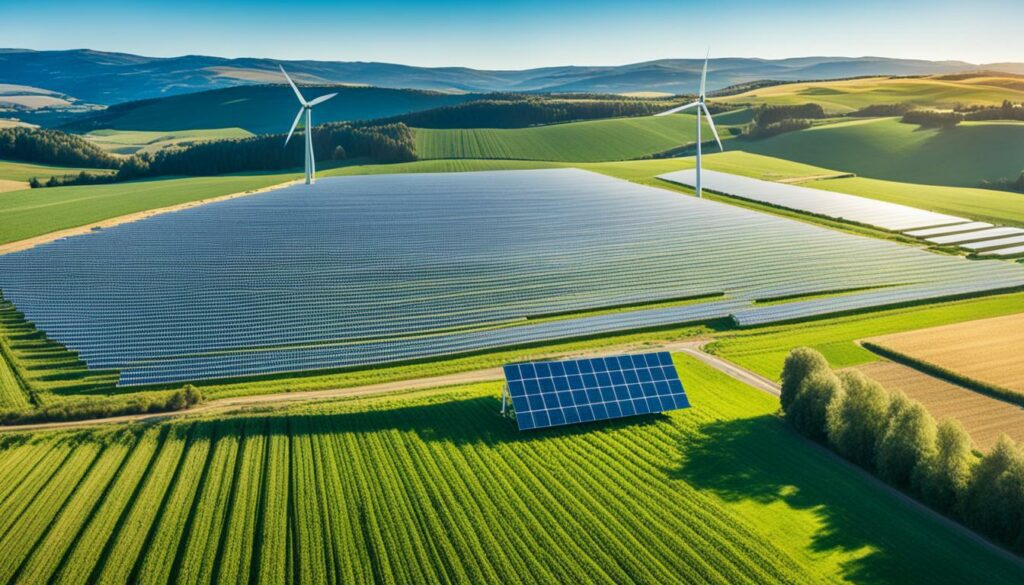
Adding renewable energy solutions to farming faces big challenges. These include high tech demands and not enough money. These obstacles often stop farms from becoming more sustainable.
Farming uses a lot of the world’s energy, about 30%. But, it mainly uses fossil fuels, which are bad for the environment. Switching to solar and wind power has its own issues. Their up-and-down supply needs special technology to store energy, which is expensive and not always easy to use.
Also, the equipment for renewable energy can be very different. This makes putting it all together hard. Plus, each area might have their own rules for using these new technologies.
It costs a lot to start using renewable energy on farms. Even though it can save money and lower harmful emissions, the big spend upfront is a problem. Money for research in these new energy areas is also not enough. This lack of funding slows down the invention of better technologies for farms.
Rules and policies can also make things difficult. Often, it’s cheaper to use fossil fuels than the cleaner options. Different places also have different laws. This affects how quickly and how costly it is to change to renewable energy.
Some people don’t want solar or wind farms near where they live, making the journey to approval hard. It also costs a lot and takes a long time to build the power lines that connect these renewable farms to the wider energy network. Many times, locals and nature groups protest these projects.
In essence, while the aim is to foster a more sustainable and resilient agricultural sector through renewable energy integration, overcoming these technical and financial barriers, alongside navigating policy and regulatory hurdles, remains a formidable challenge.
Renewable energy in farming brings many good things. These include helping the environment, making money, and being secure with energy. Using these new ways helps with farming that doesn’t harm nature and helps to make more money.
Renewable energy means less bad stuff in the air, like a smaller carbon footprint. For example, using waste to make energy lowers greenhouse gas emissions. Solar panels and wind power make farms use less fossil fuels and help wildlife. Water power is another way that’s good for the planet.
Green energy is good for the wallet too. For instance, farming energy crops could make farmers lots of money, up to $20 billion in the U.S. By selling meal instead of oil from these crops, farmers can earn more.
Solar water heaters can save a lot on heating costs. And wind turbines are good because they work day and night, potentially saving a lot of money and creating jobs too.
Using renewable energy makes farms more self-sufficient. Geothermal systems can heat and cool buildings without gas or electricity. Solar panels and wind turbines lessen the power bill and keep energy flowing, reducing the chance of blackouts.
These systems also come with money-saving benefits like tax credits. So, they make farms more secure and able to make their own energy.
| Benefits | Statistics |
|---|---|
| New Income for Farmers | $20 billion from increased biomass use |
| Heating Cost Reduction | Up to 85% annually with solar water heaters |
| System Payback Time | 5-10 years for geothermal systems |
| System Lifespan | 20-25 years for small hydroelectric systems |
| Cost Range for Wind Turbines | $13,000 to $40,000 for residential systems |
| Contribution to Global Energy Consumption | Food production and processing account for one-third |
These green energy solutions don’t only save money, they also help the planet. By using green methods, farms can power themselves well, which is good for the environment and the wallet. This way of farming is key to being both efficient and safe for the future.
Renewable energy plays a key role in eco-friendly farming. It helps lower the carbon footprint of agriculture. Currently, farming uses a third of the world’s energy. This shows the strong need for green practices.
Solar power is great for farms. It lasts over 25 years with little cost to run. Despite the initial high price, it leads to savings and even extra money from selling power. Sunny Acres, for example, saves a lot and shares its extra power with others.
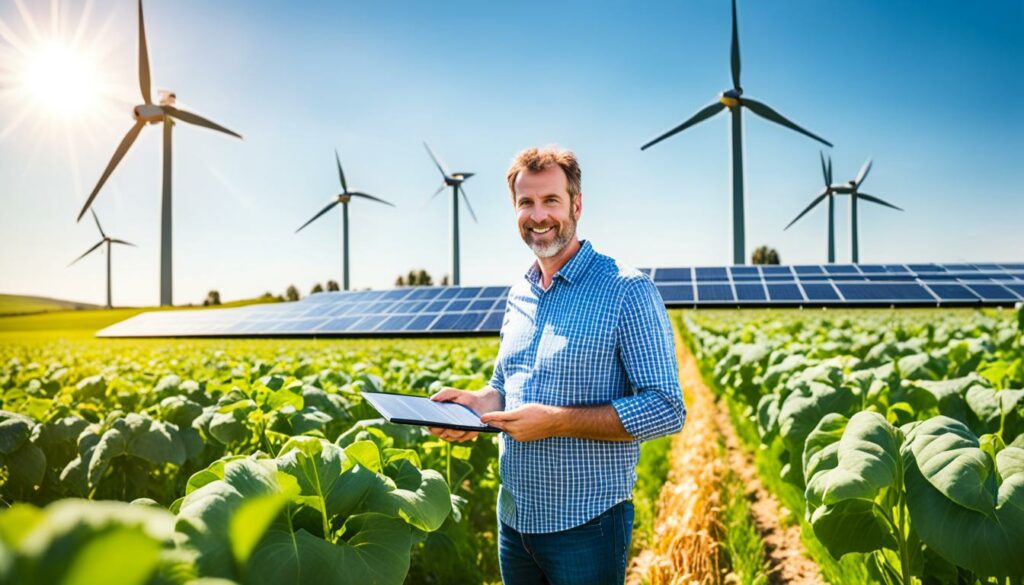
Wind power is also useful, though it depends on the wind. It can have some challenges, like its look and bird safety. But, these issues can be solved with proper planning and tech. Using farm waste for energy is another win. It cuts down waste and shows a link between green farming and energy.
Hydropower and geothermal energy are also great options. Hydropower gives steady power but can meet problems with nature and rules. Geothermal works well for temperature control, but it needs costly setups.
Adding renewable energy to farms is good for business and the planet. It makes farming more green and less addicted to fossil fuels. Such actions also cut costs and help farms stay afloat during blackouts.
Still, going green faces big hurdles like cost and rules. Good planning and knowing the laws are key. New tech like sensors and smart systems are easing the way to efficient, green farming.
Using green energy, farms can lead the way in protecting nature and saving money. Sunny Acres and Greenfields Ranch show this well. They have become more productive and nature-friendly by using renewable energy.
Looking at renewable energy projects in farming shows great progress. Projects that join different areas, like the Green Climate Fund, are leading the way. They show how working together can boost energy use and keep farms productive for the long term.
Farming uses a lot of the world’s energy and mainly from fossil fuels. This leads to lots of greenhouse gas emissions. In places like Zambia, using solar, wind, and biomass is now common. These cleaner energies help farms work better for the planet. For example, solar-powered systems let farmers use water better without expensive diesel. This way, crops grow with less water but still do well.
Working together in different parts of the economy shows real success. The Green Climate Fund is a good example. It uses money in smart ways to fight climate change in farming. This approach is making farming cleaner and more sustainable.
Another big effort is the Power Africa project. It connects with many groups to bring electricity to rural areas. In places like sub-Saharan Africa, this power helps farms grow more. It also brings benefits to the people living there. Strong partnership projects like this are changing how farms and communities thrive.
In the last few years, farming and renewable energy have been working together more. This teamwork has sparked new, green power projects. These projects help the environment, save money, and secure energy for farmers. They also fight against the gas emissions from food production.
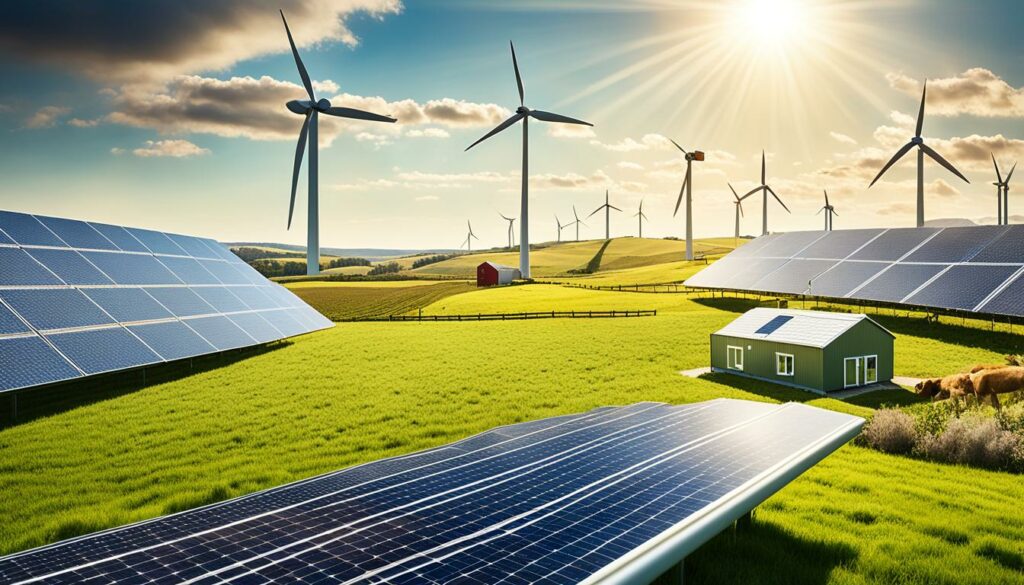
Farming with wind power is a standout success. Farmers are putting up wind turbines on their land. This move not only helps the planet but also boosts their earnings. The ENER2I project showed how wind power can work well on farms. It helped farmers join the fight against climate change. At the same time, they could keep up their sustainable practices.
Solar farming is another exciting field in this partnership. Growing crops under solar panels, known as agrivoltaic farming, helps the land and makes it more efficient. Studies show that these solar arrays can use water up to 300% better. Solar panels on farms have also made sheep produce better wool. This shows both sides can win with these solar farming projects.
| Project Type | Number of Projects | Funding Amount (EUR) | Workshops Held |
|---|---|---|---|
| Wind Energy | 30 | 120,000 | 8 |
| Solar Farming | 30 | 120,000 | 8 |
Green power projects are key for a sustainable future in farming. With the world’s population growing, we must focus on sustainable farming. This is more important than ever before, powered by renewable energy solutions.
Innovative farming methods are changing agriculture for the better. They make farming more sustainable and kinder to the planet. Things like organic farming and agroforestry, mixed with renewable technologies, look very promising for a green future.
Organic farming now uses renewable energy to be even greener. For example, renewable technologies in agriculture include biogas from organic matter. This biogas can be used for cooking and heating on farms. It helps make the farming of food and other crops healthier and cuts down on harmful greenhouse gases. These gases cause a lot of global warming.
Agroforestry mixes growing trees with crops. It makes land use more varied and productive. Studies show that solar panels in agroforestry can make water use over 300% more efficient. This supports the farming method of agrivoltaics. So, these renewable technologies are helping agroforestry be even better. They add to both energy production and better crop growth.
Climate-smart farming can also make a big difference. If 20% more EU farmers use these methods by 2030, greenhouse gases could drop by 6%. This would make 14% more farmland healthier. It fights climate change and helps farmers make more money. So, there’s an important economic gain from choosing eco-friendly farming methods.
| Eco-Friendly Farming Method | Impact | Renewable Technology Utilised |
|---|---|---|
| Organic Farming | Reduces carbon footprint and improves crop quality | Biogas, solar energy |
| Agroforestry | Enhances biodiversity and water efficiency | Solar panel arrays, agrivoltaic systems |
The use of renewable energy in farming is growing fast. This is thanks to new tech that brings sustainable and effective solutions. For example, solar power is changing how farms manage water. It’s making things better for the environment and for saving money. Biomass boilers and energy-efficient greenhouses are also on the rise. They help crops grow well without using too much energy.
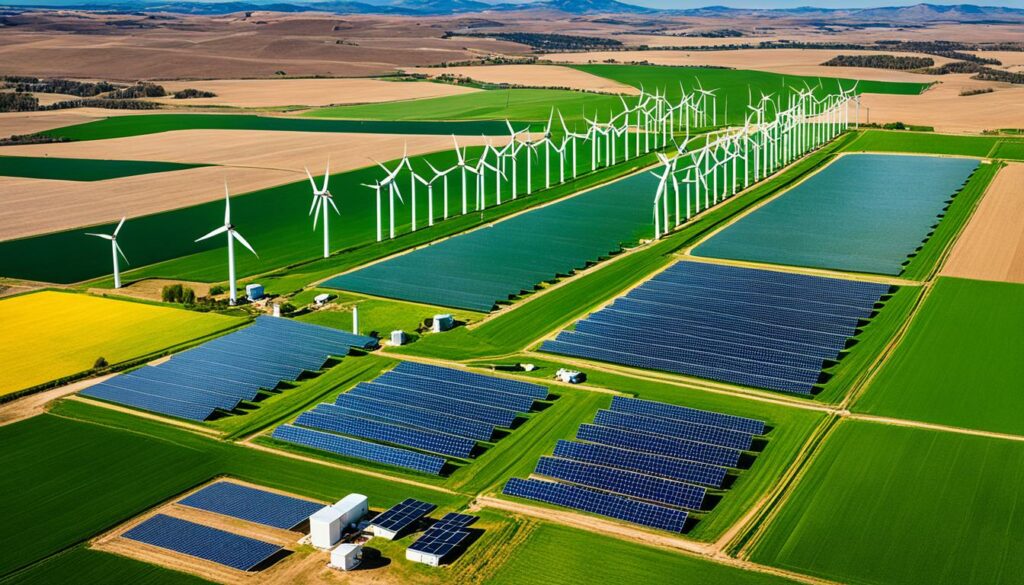
New tech is key in using renewable energy in farming. Worldwide, photovoltaics are powering farm tasks like lighting and water pumping. They help save money and are good for the planet. Using biomass for energy could earn farmers and country areas up to $20 billion. Small oil presses, costing from $400 to $13,000, let farmers make fuel cheaply. This is especially good when the byproduct is worth more than the oil.
There are many success stories showing how renewable energy works well in farming. In Indonesia, the solar and battery project in East Sumba is a great example. It powers thousands of homes and shows how rural areas can be energy independent. Small hydro systems are also proving useful, lasting 20-25 years. They provide steady, renewable power for farms. Solar water heaters, approved by the SRCC, are trusted to heat water for farms.
The future of farming is looking towards being both more energy efficient and eco-friendly. New technologies like battery storage are set to make a big difference. They store extra energy to use later, making energy more reliable. In places like Ireland, there is a lot of room to grow in using renewable tech in farming. Collaborations in solar and anaerobic digestion can help a lot. But, it’s important for everyone to work together. This includes farmers, communities, and landowners. They need to talk and work together to make sure renewable energy in farming is a success.
| Technology | Application | Cost | Lifespan |
|---|---|---|---|
| Small-scale Oil Presses | Fuel Production | $400 – $13,000 | Variable |
| Photovoltaics | Power Lighting, Motors, Pumping Water | Variable | Variable |
| Small Hydroelectric Systems | Renewable Energy Supply | Variable | 20-25 Years |
| Certified Solar Heaters | Water Heating | Consult SRCC | Variable |
Cross-sector partnerships in renewables are powerful for change, especially in agriculture. They bring together government, private, and civil sectors. This mix of expert knowledge and resources is vital for change. Over 70 countries aim to achieve net-zero carbon emissions by 2050, highlighting the need for such partnerships to hit these targets.
Money matters a lot too. To reach net-zero emissions by 2050, we need an extra $1-2 trillion each year. Europe, for example, requires a huge $3.8 trillion for new energy projects from 2021 to 2050. This shows why joint funding is crucial.
There’s power in partnerships like the one between the International Renewable Energy Agency (IRENA) and the International Chamber of Shipping (ICS). They focus on making shipping greener to cut down one-third of global warming. Such efforts are key to increasing the use of clean energy by 2030.
Big meetings like ADIPEC and the COPs are very important too. They allow discussions on how these partnerships can drive changes and create new policies. Agriculture relies on old, polluting ways for 30% of its energy needs, mainly for food. This stresses the need for big changes in this area.
Women face more struggles with energy access, mainly in farming and health. Renewable energy backed by these partnerships can help. It boosts work and money for them, while fighting climate problems. The ‘Empowering Lives and Livelihoods’ project is a good model. It provides financial help that fits the needs of hardest-hit places.
To sum up, cross-sector partnerships play a key role in pushing farming towards a greener future. They aim at environmental and fairness goals. By working together, they pave the way for a better, more sustainable world.
Stakeholder engagement is key for farming and renewable energy projects to succeed. It pulls together the strengths of different groups. This process creates sustainable solutions and fights food security issues. Each player, be it the government, private sector, or civil society, adds something special.
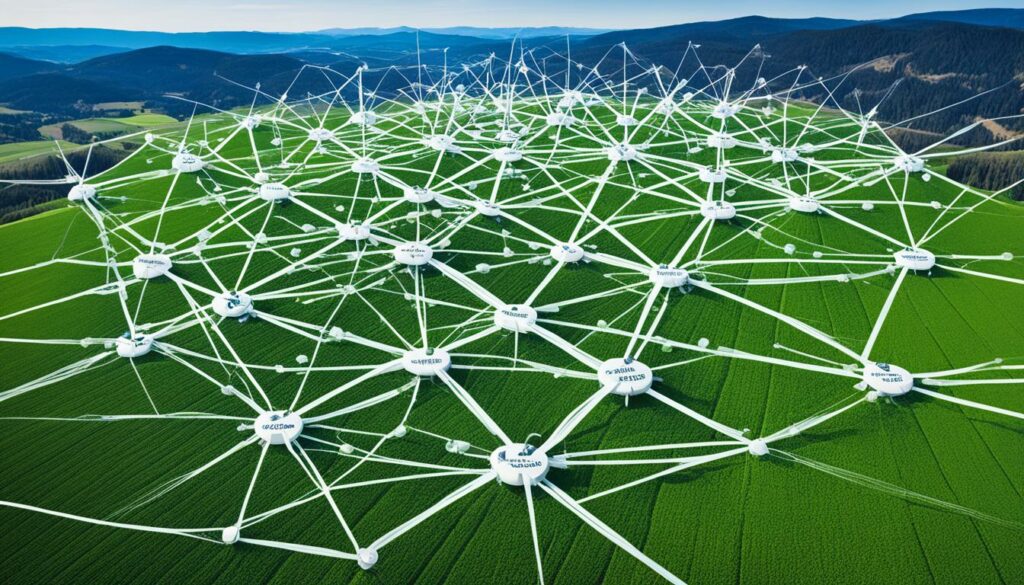
Governments are essential in pushing forward green energy. They make policies that encourage the use of sustainable tech. Things like tax breaks and grants help companies work on these projects. Movers and shakers also check that these efforts meet the country’s green goals for the future.
The private sector is crucial in developing new green technologies. They fund experimental projects and help successful ones grow. Working with the government and NGOs, companies can do even more. This teamwork boosts the use and effectiveness of renewable energy, helping with both business goals and saving the planet.
Civil society groups and NGOs make sure the community is a part of renewable energy projects. They lead local efforts, making sure everyone’s voice is heard. These groups focus on fairness and making sure everyone gets the help they need. Thanks to their work, renewable projects can be more successful and long-lasting.
Finally, everyone, from governments to private companies and local groups, is needed to make green farming work. By using everyone’s skills, we can create a future where agriculture doesn’t harm the planet.
Renewables in farming save a lot of money and push rural areas forward. These projects help cut costs and improve business thanks to teamwork between farming and renewable energy. This teamwork is creating new ways to make money and is good for the economy overall.
Farms using solar panels and wind turbines spend less on energy. They don’t need as much fossil fuel, so they save on costs. As green tech gets cheaper, these savings will only get better for farmers.
Setting up wind turbines and making solar panels means more jobs in farming. These jobs range from simple tasks to skilled work. This also helps towns grow, bringing in more money and making the area better.
Looking at how farming works together on green energy is full of cool stories. These projects show how much can be done when we work as a team. They teach us about change and how it helps the world.
Europe leads the way in sharing energy ideas in farming. They mix new green tech with old-style farming very well. This makes the farm work greener and better.
Germany has a big plan called the Energiewende. It’s all about quitting fossil fuels by 2050. They use more green energy and have cut down a lot on bad gases. Denmark loves windy places, so they have lots of windmills in the sea. These help farms be more green, too.
The UK has large wind farms in the sea to get electricity. It powers farms in a cleaner way. This means farms there make less mess and spend less money.
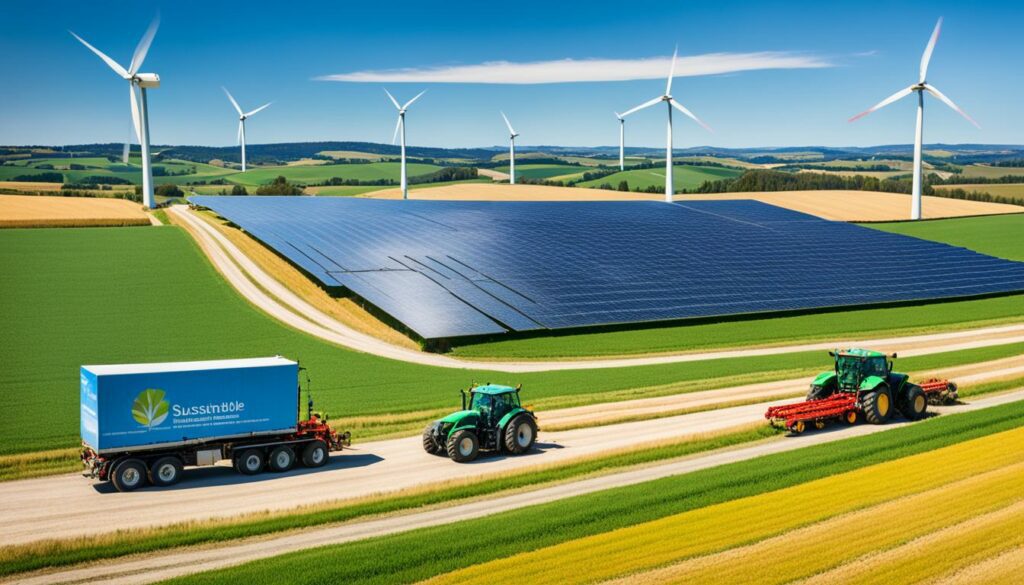
Over in the US, farming and green energy are becoming best friends. They come up with new cool ways to farm that help nature and save money. It’s a win-win.
Places like California are big on using the sun for power. They give prizes to farms if they use solar panels. This helps the farms use less bad energy from the ground.
One neat thing they do is use the sun to water the crops. This makes the farms better at growing food. It also saves a lot of water. The government helps pay for these systems, making it easier for farms to get them.
Looking at these stories, it’s clear that using new tech in farming is a game-changer. It makes farms cleaner, richer, and better for everyone. It’s a path that others can follow, making the whole world greener.
| Region | Initiative | Impact |
|---|---|---|
| Germany | Energiewende | Reduction of greenhouse gas emissions |
| Denmark | Offshore Wind Farms | Enhanced renewable energy capacity for agriculture |
| United Kingdom | Offshore Wind Projects | Operational cost savings and lower carbon footprint |
| United States | Solar Irrigation Systems | Higher crop yields and improved food security |
| California | Solar Power Adoption | Reduced dependence on fossil fuels |
These projects show the power of working together for a greener farm future. From Europe to the US, it’s clear that good ideas spread. The success of these efforts tells us how to make farming better for the planet, no matter where we are.
Looking towards the future, we see chances for big changes. New tech, smart policies, and more funding are bringing exciting possibilities. These could transform our world. We’re talking about everything from high-tech farming to ways to support it. This could be a game-changer for making our future greener.
New tech is set to change farming for the better. Think satellites and clever data use. They’re already helping us fight greenhouse gases. This could make farming more eco-friendly. Plus, it’s key in reaching worldwide climate goals. Energy and digital companies working together are a big part of this. They’re focusing on solutions that cut carbon and boost farming sustainability.
But, we also need smart rules to back these tech advances. Policies that encourage new ideas and bring clean energy to farms are needed. Big talks, like those at ADIPEC and COPs, are where leaders come together. They discuss how to support these changes. It’s a global effort that needs billions in yearly investments. With the right support, we can turn our green dreams into reality.
Making these green changes also takes a lot of money. In Europe, for example, there’s a big need for investment. This includes trillions for new power and green hydrogen by 2050. The private sector is getting on board. They see the value in supporting these bold moves. This support is crucial for introducing new tech and building the needed structures.
Across the board, from tech to policies to finance, there are paths to a greener future. We just have to grab these chances and work together. By linking up different sectors, we can push for an eco-friendly future in farming.
Cross-sector teamwork combines various sectors’ knowledge and skills. This teamwork is vital for meeting worldwide commitments to lower carbon and achieve climate goals. Working together is key for the farming sector to adopt sustainable energy practices.
The government, private businesses, and non-profits all have important parts to play. Governments make rules and offer rewards, businesses put in money, and non-profits support local initiatives. Together, they push forward efforts to be more sustainable.
The work between ADNOC, BP, and Masdar on green hydrogen shows how sectors can join forces. They use their skills and resources together to drive green projects. This is a great example of effective multi-sector teamwork in energy transition.
One challenge is making farm equipment work on new energy sources. Another is how to use large-scale renewable tech effectively. These are the main hurdles to bring renewables into farming.
Getting money for renewable projects is tough. Often, the wait for returns on investments is too long. This delays the switch to green farming.
Favouring fossil fuels over renewable can slow down progress in farming. Policies need to encourage green energy use. Without the right rules, it’s hard for farms to go green.
Using renewable energy means less pollution and more biodiversity. It’s also great for the land and water. These changes make farming better for the environment.
Green energy can save money in the long run. It also helps grow rural areas. More jobs and a stronger economy come from using renewable energy in farming.
Less fuel dependency means farms can control their energy better. They are not as affected by changing fuel prices. Renewable energy gives farms a more stable energy source.
Green energy like solar power cut down on harm to nature. They help keep the ecosystem healthy. This is how farming can be more sustainable.
Projects like Power Africa have made a big difference in Africa. They’ve brought renewable energy into farming. This has made farming more sustainable.
The ICS and IRENA’s partnership is a good example. They are reducing pollution in shipping. This shows how sectors working together can benefit the whole supply chain.
Wind power means clean energy and extra money for farmers. They lease their land for turbines. This shows how wind energy and farming can work well together.
Governments, businesses, and non-profits all help in different ways. They offer support, money, and work on local projects. Together, they help more renewable energy be used in farming.
Working together saves money, makes jobs, and helps rural areas grow. This supports the economy through green solutions.
Europe leads with big investments in wind and solar. They show how farming can use renewable energy effectively. It’s a strong statement for sustainable practices on the continent.
New tech, policies, and more money offer many chances for teamwork. They aim to make farming more sustainable with renewable energy. The future looks bright for these collaborations.